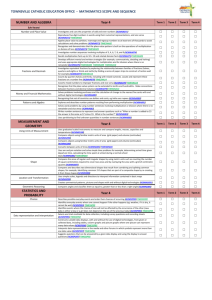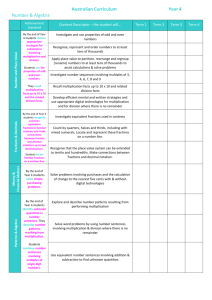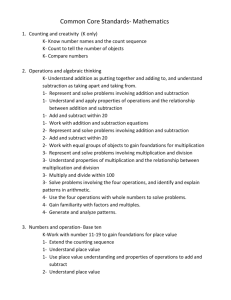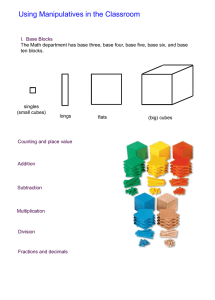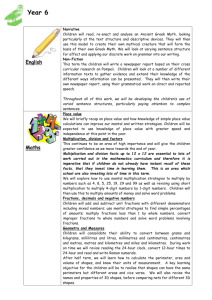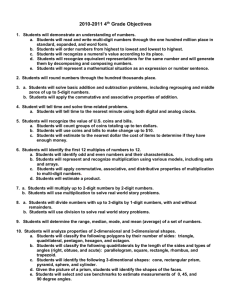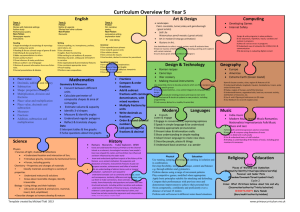SUMMARY SHEET – GRADE 4 OUTCOMES
advertisement
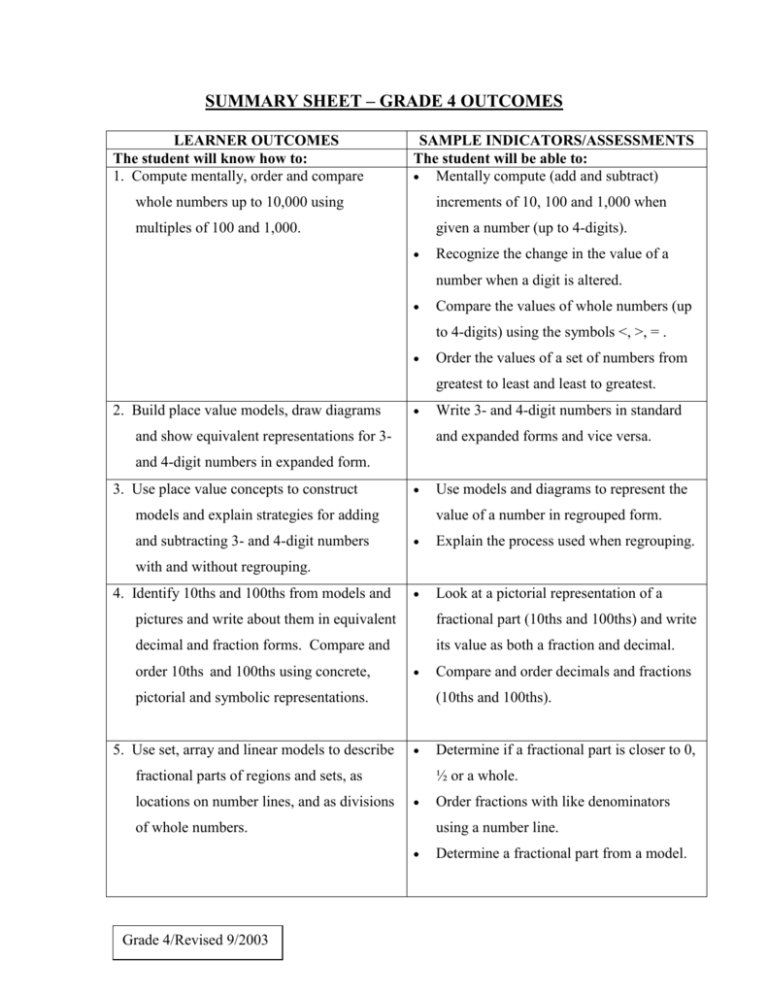
SUMMARY SHEET – GRADE 4 OUTCOMES LEARNER OUTCOMES The student will know how to: 1. Compute mentally, order and compare SAMPLE INDICATORS/ASSESSMENTS The student will be able to: Mentally compute (add and subtract) whole numbers up to 10,000 using increments of 10, 100 and 1,000 when multiples of 100 and 1,000. given a number (up to 4-digits). Recognize the change in the value of a number when a digit is altered. Compare the values of whole numbers (up to 4-digits) using the symbols <, >, = . Order the values of a set of numbers from greatest to least and least to greatest. 2. Build place value models, draw diagrams and show equivalent representations for 3- Write 3- and 4-digit numbers in standard and expanded forms and vice versa. and 4-digit numbers in expanded form. 3. Use place value concepts to construct models and explain strategies for adding and subtracting 3- and 4-digit numbers Use models and diagrams to represent the value of a number in regrouped form. Explain the process used when regrouping. Look at a pictorial representation of a with and without regrouping. 4. Identify 10ths and 100ths from models and pictures and write about them in equivalent fractional part (10ths and 100ths) and write decimal and fraction forms. Compare and its value as both a fraction and decimal. order 10ths and 100ths using concrete, pictorial and symbolic representations. 5. Use set, array and linear models to describe (10ths and 100ths). fractional parts of regions and sets, as locations on number lines, and as divisions Determine if a fractional part is closer to 0, ½ or a whole. of whole numbers. Order fractions with like denominators using a number line. Grade 4/Revised 9/2003 Compare and order decimals and fractions Determine a fractional part from a model. 6. Order and compare amounts of money to $99.99. 7. Round a whole number or decimal to a $99.99. given place value. 8. Construct arrays to begin to recognize Round a decimal to a whole number. Determine whether a given number (2 – 20) is prime or composite. basic facts of addition. doubles plus 1, doubles minus 1, make a basic facts of subtraction. ten, count on, count back). associative and distributive properties of addition and multiplication. Use appropriate addition/subtraction strategies (e.g., fact families, doubles, 9b. Use strategies to develop fluency with 10. Use and understand the commutative, Round a whole number to its largest place value or a given place value. prime and composite numbers. 9a. Use strategies to develop fluency with Order and compare money amounts to Identify and use the commutative property of addition and multiplication. Identify and use the associative property of addition and multiplication. Identify and use the distributive property of multiplication. 11. Apply a variety of algorithms (procedures) Solve 2-, 3- and 4-digit addition and for computation of addition and subtraction subtraction problems using a variety of of 2- and 3-digit numbers with and without algorithms. regrouping. 12. Relate multiplication and division to models with groups and rectangular arrays. 13a. Use strategies to develop fluency with Match pictorial representations to multiplication and division equations. basic facts of multiplication. Use appropriate strategies to solve multiplication and division facts. 13b. Use strategies to develop fluency with basic facts of division. 14. Apply a variety of algorithms (procedures) for multiplying and dividing 2- and 3-digit whole numbers by a 1-digit number and by multiples of 10 and 100. Grade 4/Revised 9/2003 Multiply and divide 2- and 3-digit numbers by 1-digit using a variety of algorithms. Solve 2- and 3-digit problems when multiplying or dividing by 10 and 100. 15. Write and solve multiplication and division story problems that represent the Write and solve multiplication and division story problems. meaning of these operations. 16. Analyze and solve multiple-step story Use appropriate operations of addition, problems for all 4 operations including subtraction, multiplication, and division to those with extraneous and insufficient solve story problems. information. Highlight key information in story problems. 17. Using models and pictures, represent equivalent fractions and write fractional Identify extraneous/needed information. Identify equivalent fractions. Write a fractional number sentence to number sentences to add and subtract fractions with like denominators. describe a model. Identify and illustrate addition and subtraction of fractions with like denominators. 18. Find sums and differences with 10ths and Find sums and differences of decimals 100ths in decimal form using concrete, (10ths and 100ths) using concrete, pictorial pictorial and symbolic models in real-life and symbolic models. problem solving activities. 19. Use standard and non-standard units for Solve real-life problems using decimals. Estimate length, height and area of objects estimating measures of length, height and in standard and non-standard units using area. benchmarks (referents). 20. Use and explain orally and in writing a Use a variety of estimation strategies to variety of estimation strategies to solve problems with whole numbers, determine quantity, make comparisons and fractions and money. compute using whole numbers, fractions and money. strategy was used. 21. Determine the reasonableness of an answer and recognize when estimation is appropriate and useful as distinct from an exact answer. Grade 4/Revised 9/2003 Explain why a particular estimation Determine when estimation is appropriate for solving problems. Determine the reasonableness of an answer in an estimation problem. 22. Select the estimation strategy that is best suited to the problem type. Choose the estimation strategy that is best suited to the problem type. Compute with large numbers using various methods of mental computation. Explain why a particular estimation strategy resulted in an over- or underestimation. 23. Use simple ratios to make a variety of Use ratios to make comparisons. Convert fractions to decimals and percents comparisons to show how the change in one quantity results in the change in another. 24. Develop an understanding of relationships between basic fractions, decimals and and vice versa. percents. 25. Perform simple standard unit conversions, Convert simple units of measurement. Determine and use appropriate units of such as inches to feet or meters to centimeters. 26. Using whole numbers and fractions, choose the appropriate customary or metric measurement to solve real-world problems. unit to measure length, perimeter, area, weight, capacity, volume, and temperature. 27. Calculate elapsed time in hours and minutes. Convert between time units, such as days to weeks, minutes to hours. 28. Investigate the area of various rectangles and use the formula (A = 1 w) to determine the area. Grade 4/Revised 9/2003 Calculate elapsed time in hours and minutes. Perform proper conversions of time. Understand and use the formula to determine area. 29. Classify, describe and construct line segments, rays, lines and angles. Distinguish between parallel, intersecting and perpendicular lines. Distinguish between acute, obtuse and right angles. Construct line segments, rays, lines and angles. 30. Classify, describe and build 2- and 3- Recognize and describe the differences and dimensional figures and describe the similarities between 2- and 3-dimensional properties that define classes of polygons figures. and solids. 31. Make and test conjectures about geometric Construct 2- and 3-dimensional figures. Transform various shapes and figures using properties and relationships involving shape, subdivision, tessellation and rotations, translations and reflections. transformations. Subdivide a geometric shape and describe the resulting shapes. Recognize which geometric shapes tessellate and use those shapes to create a tessellation. 32. Make and use coordinate systems to specify locations. 33. Explore congruence, similarity and line Read points on a grid. Plot ordered pairs on a grid. Recognize the differences and/or symmetry of 2-dimensional shapes. similarities between similar and congruent Explore congruence, similarity and plane shapes. symmetry of 3-dimensional shapes. Determine the shapes that result from a drawn line of symmetry of 2-dimensional shapes. Determine the shapes that result when using plane symmetry of 3-dimensional figures. Grade 4/Revised 9/2003 34. Relate geometric shapes to nature and the Recognize and describe 2- and 3- real world and solve problems using dimensional figures and connect them to geometric concepts. real-world objects. Use geometric concepts to solve real-world problems. 35. Examine and explain the likelihood of Explain the likelihood of events using events in the real world including the percentages, such as certain (100%), probability of events that are certain impossible (0%) and equally likely (50%). (100%), impossible (0%) and equally likely Explain the likelihood of events in the real (50%). Use always, never, sometimes to world using the words always, never and describe whether an event will happen. sometimes. Begin expressing probability in the form of a fraction and place it on a number line 36. Make predictions, list possible outcomes Use fractions and number lines to express probability. Explore probability and fairness using and test predictions to explore elementary number cubes, spinners, games and notions of probability and fairness. activities to make and test predictions, and list possible outcomes. 37. Design investigations to address a question, predict, systematically collect, record, organize, analyze, and interpret the Collect and organize data in real-world situations. Interpret the data collected by recognizing data. Using the organized data, recognize patterns, making predictions and patterns and trends, make new predictions, conjectures and drawing conclusions from form and defend reasonableness of data. conjectures and draw conclusions from data. 38. Create and interpret graphs, 2-set Venn diagrams, tables and charts. 39. Determine and analyze the mean, median, diagrams, tables and charts. mode and range in different settings, using given or student-generated data. Complete and interpret graphs, 2-set Venn Analyze the mean, median, mode and range, and compare related data sets. Describe the various shapes and features of sets of data including the effect of outliers. Grade 4/Revised 9/2003 40. Extend, classify and describe the Recognize and extend geometric and sequences and relationships of patterns. numerical patterns and explain the rule in Develop and test generalizations based on written form. observations of geometric and numerical patterns. 41. Represent and analyze patterns and functions, describing their rules using Write an equation to describe the function rules in tables, graphs and charts. words, tables, graphs and simple equations. 42. Recognize that patterns exist in the real world. Recognize patterns in real-world situations and express their explanations in written form. 43. Represent mathematical relationships using variables in expressions, equations Complete expressions, equations and inequalities that include variables. and inequalities. 44. Express mathematical relationships and represent the concept of a variable as an unknown quantity using a letter or symbol Complete a simple equation by solving for the unknown quantity. in simple equations and match equations to Solve word problems by choosing the correct algebraic expression. word problems. 45. Sort and classify data based on multiple Sort and classify data into groups based on attributes, using the empty set where common attributes and defend their appropriate. decisions in written form. Complete a Venn diagram using an empty set. 46. Explore simple combinations, Use concrete and pictorial models (e.g., permutations and sequences using concrete tree diagrams) to create combinations, and pictorial models. permutations and sequences. Grade 4/Revised 9/2003 47. Comprehend and follow a practical set of Use a variety of strategies (e.g., pictorial directions to develop a solution to a models, charts, tables, graphs, organized multiple-step task. lists) to communicate mathematically and solve problems. 48. Use organizational skills to develop an Select and use an organizational strategy to outcome to a real-world situation in which develop an outcome to a real-world more than one solution is possible. problem with multiple solutions. Grade 4/Revised 9/2003

